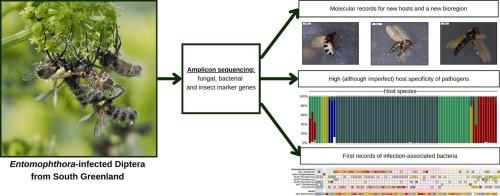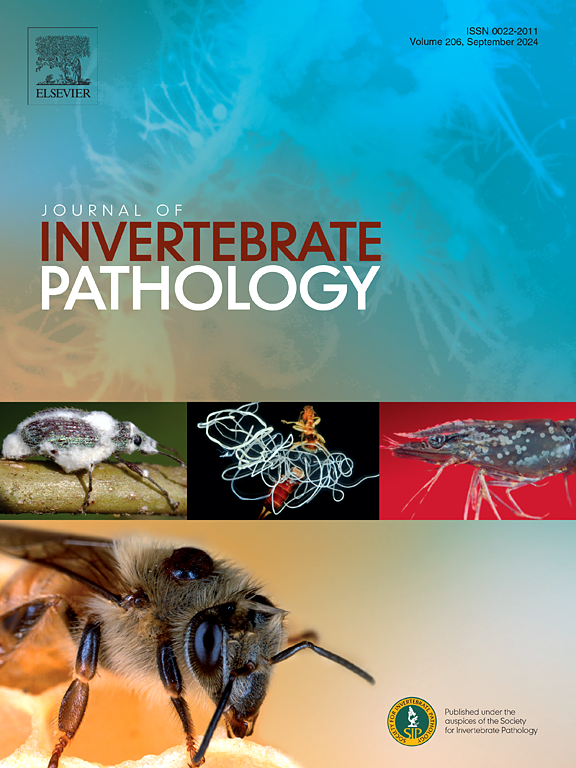解剖多营养相互作用:疫霉及其双翅目宿主和相关细菌之间的关系
IF 2.4
3区 生物学
Q1 ZOOLOGY
引用次数: 0
摘要
在整个寄生虫-共生连续体中,与微生物的相互作用在各个层面上塑造了昆虫的生物学特性——从个体特征到种群再到群落。然而,对感染自然生态系统中非模式昆虫物种的病原体,或它们与其他昆虫相关微生物的相互作用的了解是不完整的。在这里,我们测试了一种概念上新颖的方法——同时测序昆虫、真菌和细菌标记基因扩增子——作为解剖南格陵兰昆虫疫霉属昆虫病原真菌与其双翅目宿主之间相互作用的一种手段。我们的目的是描述昆虫疫霉的分类多样性,它们的双翅目宿主,和细菌多样性在一组田间收集的死昆虫显示昆虫疫霉感染的迹象。在收集到的9个双翅目物种中,我们鉴定出了多个昆虫疫霉基因型,在5个目标标记区域中具有很强但不完美的宿主特异性模式。此外,我们发现真菌杀蝇种类和采样地点的细菌群落组成存在一致的差异。我们的研究结果大大扩展了对疫霉多样性和宿主关联的认识,同时提供了对相关细菌及其潜在作用的第一次见解。我们还得出结论,多靶点扩增子测序可以成为解决各种自然群落中生物相互作用的广泛问题的有力工具。本文章由计算机程序翻译,如有差异,请以英文原文为准。

Dissecting multitrophic interactions: The relationships among Entomophthora, their dipteran hosts, and associated bacteria
Interactions with microorganisms across the parasite–mutualist continuum shape the biology of insects at all levels − from individual traits to populations to communities. However, the understanding of pathogens infecting non-model insect species in natural ecosystems, or their interactions with other insect-associated microorganisms, is fragmentary.
Here, we tested a conceptually novel approach − the simultaneous sequencing of insect, fungal, and bacterial marker gene amplicons − as a means of dissecting interactions among entomopathogenic fungi in the genus Entomophthora and their dipteran hosts in South Greenland. We aimed to describe the taxonomic diversity of Entomophthora, their dipteran hosts, and the bacterial diversity within a set of field-collected dead insects exhibiting signs of Entomophthora infection.
Across nine collected dipteran species, we identified multiple Entomophthora genotypes, with strong but not perfect patterns of host-specificity across the five targeted marker regions. Additionally, we found consistent differences in bacterial community composition among fungus-killed fly species and sampling sites. Our results substantially expand the knowledge of Entomopthora diversity and host associations while providing the very first insights into associated bacteria and their potential roles. We also conclude that multi-target amplicon sequencing can be a powerful tool for addressing broad questions about biological interactions in diverse natural communities.
求助全文
通过发布文献求助,成功后即可免费获取论文全文。
去求助
来源期刊
CiteScore
6.10
自引率
5.90%
发文量
94
审稿时长
1 months
期刊介绍:
The Journal of Invertebrate Pathology presents original research articles and notes on the induction and pathogenesis of diseases of invertebrates, including the suppression of diseases in beneficial species, and the use of diseases in controlling undesirable species. In addition, the journal publishes the results of physiological, morphological, genetic, immunological and ecological studies as related to the etiologic agents of diseases of invertebrates.
The Journal of Invertebrate Pathology is the adopted journal of the Society for Invertebrate Pathology, and is available to SIP members at a special reduced price.

 求助内容:
求助内容: 应助结果提醒方式:
应助结果提醒方式:


